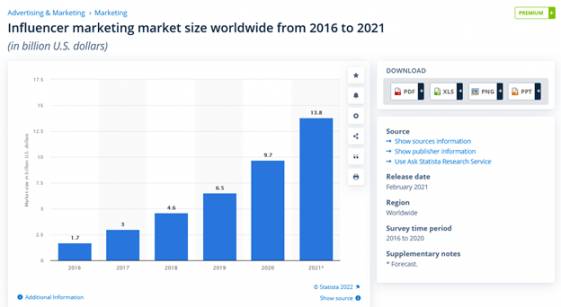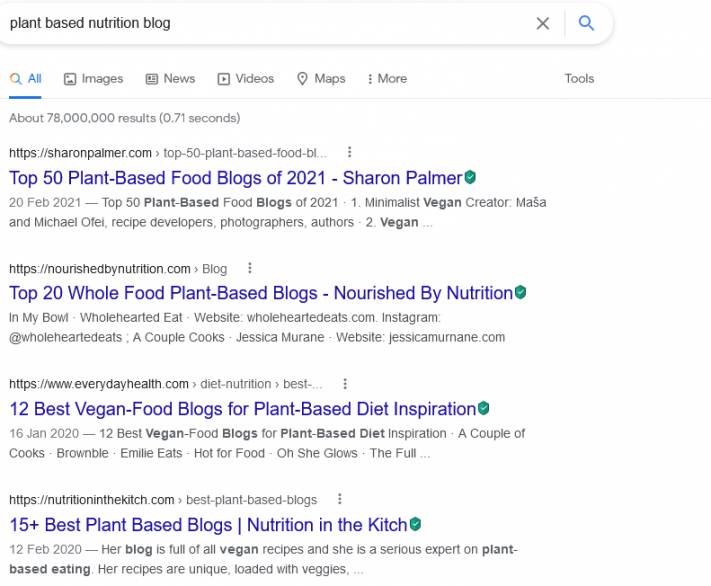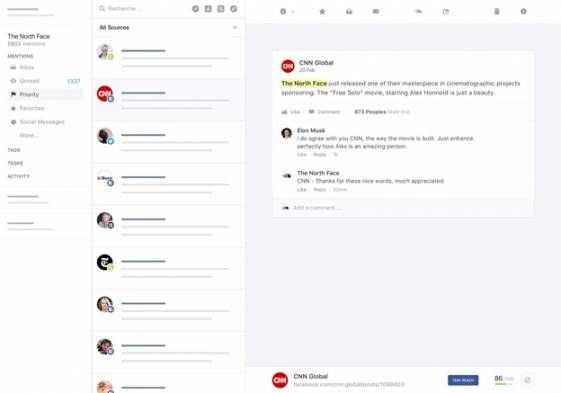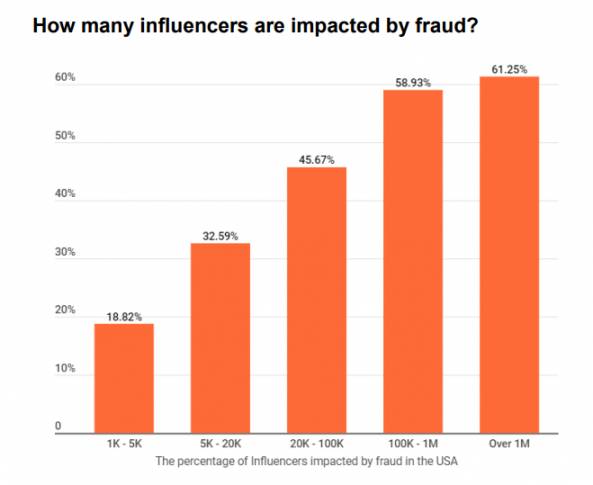Wondering how to find micro-influencers that are the right fit for your campaign?
We understand your dilemma.
The influencer market size is massive and growing exponentially!
Per Statista, it’s been steadily increasing since 2016.
In 2021, the influencer marketing market size was worth $13.8 billion compared to $9.7 billion in 2020. That’s quite a jump!

Image via Statista
The reason for this market growth is that there are consistently new micro-influencers entering the market. Luckily, almost all of them are looking to collaborate with brands!
These micro-influencers have the numbers you need to create brand awareness, attract more customers, and direct traffic to your website.
But just numbers aren’t enough.
You want to find micro-influencers who have the content, tone, and values to match your business.
The right micro-influencer will not only attract customers; they’ll help you develop an authentic relationship with them over time.
So how do you find the right micro-influencers?
Let’s find out.
Table of Contents
5 Steps for Finding Micro-Influencers
Here are the steps you want to take to find micro-influencers who will be a fit for your marketing campaign:
Step 1: Set Your Influencer Marketing Goals
Micro-influencers can help you build awareness, boost trust, drive engagement, create content, and increase sales.
But each micro-influencer will be more effective in delivering one goal than another… it all depends on the type of content that they create and their connection with their audience.
For this reason, your journey to find micro-influencers for your business should begin by setting your goals.
This ensures that the micro-influencers you pick align with your campaign objectives.
Here’s what we mean:
Brand Awareness
If your goal is to create brand awareness, an influencer’s reach will be a deciding factor. The greater the reach and size of the influencer’s audience, the higher your brand’s exposure to new audiences will be.
Lead Generation and Brand Trust
If you’re looking to increase trust in your business, find micro-influencers who share your brand values. If they already love your products and services, that’s an added bonus!
Any promotion of your brand by these influencers will therefore be more authentic. The audience will pick up on this authenticity, and they will approach your business with the same level of trust as they have in the influencer.
Sales Generation
If your goal is to grow your customer list and drive sales, find micro-influencers who have the ability to create content that inspires their audience to take action.
Their content should be engaging, and their audience should trust them deeply. When this happens, they’ll be more likely to heed the influencer’s recommendations about trying your products, thus boosting your sales.
Step 2: Create a Picture of Your Ideal Micro-influencers
You want to have a clear profile of your ideal micro-influencer before starting your search.
What qualities should they have? What are their minimum social metrics?
Here are some important features to look for:
Personality
You want to find micro-influencers who have common interests with your brand.
Does the vibe of their content match with your brand voice? If it doesn’t, the partnership will appear inauthentic to the influencer’s audience.
An influencer who doesn’t conform to many norms, for instance, will be a good choice for a brand in the fashion industry that sells bold, unique styles because their audience is accustomed to, and enjoys, that type of vibe.
Niche
Which niches should your ideal micro-influencers be focused on? We have a few tips.
Tip 1: Go for influencers in niches that are directly tied to your products or industry already. A fitness influencer, for example, would be great for promoting an energy drink or sports apparel.
Tip 2: Choose influencers who have a similar audience to your brand. For instance, a nutrition and wellness influencer could be great for promoting a new organic snack brand. Both the brand’s and the influencer’s audiences are both health-conscious.
Tip 3: Choose influencers who share your special attributes. For example, if you sell eco-friendly makeup products, a lifestyle influencer who wears makeup and is also vocal about environmental protection will make a great choice.
Content Creativity
Remember, the influencer will be creating content that represents your brand. For this reason, it’s important to look for influencers who create high-quality content that fits your brand image.
The right influencers will have content that’s respectful, clear, well-composed, and creative … aka “scroll stopping”. Does their content stand out from all the noise on social media and stop you in your tracks?
Good Communication
Find micro-influencers who communicate promptly. Good communication makes it easy to execute your influencer campaigns well and is an indication that the influencer has the qualities to be an effective, long-term partner.
If the influencer takes too long to address your questions and inquiries, this may be a sign that they’re slow communicators or their interest in the partnership is low.
And that’s OK! Luckily, there’s millions of influencers out there for you to choose from.
Step 3: Find Micro-Influencers for Your Campaign
Now that you know the kind of influencers you want to target, the next step is to locate them.
Let’s take a look at the different ways you can find influencers.
Carry Out a Hashtag Search on Social Media
Hashtags (#) and keywords are a great way to find trending content related to your industry.
They’re also great tools for finding micro-influencers on social media platforms like Instagram, TikTok, and Facebook.
This is because any influencer who is keen on growing their brand uses hashtags.
Searching #mensfashion, for instance, will help you find micro-influencers like Adam Gonon.

Image via Instagram
Remember, you can narrow down your search by looking for hashtags related to special aspects of your business, too.
For example, if you’re in the makeup industry, you can use hashtags like #crueltyfreemakeup, #sensitiveskincare, and #darkskincare.
Search for Relevant Bloggers
You can also find micro-influencers who have niche blogs that are popular among your target market.
Like we did with hashtags, be specific with your search terms in search engines to find them.
For instance, if you’re selling plant-based supplements, search “vegan nutrition blogs” or “plant-based nutrition blogs”, which will bring up relevant search results.

Image via Google
Find Micro-Influencers Who are Already Mentioning Your Products
Though it might go without saying, micro-influencers who have already shown interest in your brand are likely to be willing to collaborate with you on sponsored content.
You can use tools like Mention to monitor your brand and product mentions. From there, you’ll be able to discover relevant micro-influencers that already use your products and who will be a natural fit for a partnership.

Image via Mention
Use a Software Platform
There are plenty of influencer search software tools and platforms out there to help you find influencers.
These range from free to fairly expensive ($10,000) monthly subscriptions.
If your brand is just getting started, you can find an effective search tool for $250 to $500 per month, but you typically get what you pay for.
A downside of many of these influencer search tools is that if your influencer requirements are very specific, the tools may return zero results.
But they tend to be effective for general searches such as the size of the audience, engagement rate, platform, and niche.
Work with an Agency
This is probably the easiest way to find micro-influencers quickly and effectively.
An influencer marketing agency like Get Hyped can help you find and recruit the right micro-influencers for your campaign to help you reach your goals.
A great influencer marketing agency will work with you as an extension of your brand. They’ll work with you from start to finish, helping you with everything from goal setting and strategy to legal agreements and whitelisting.
Step 4: Qualify Your Prospective Influencers
Remember the goals you set in step one?
Well, this is finally the stage where you ensure the micro-influencer you work with helps you reach those goals.
The idea is to filter your list of potential influencers to find the best ones.
Here’s the process:
Check Their Content
Your influencer campaign will involve content creation. Find micro-influencers whose content style matches your campaign requirements.
If you want videos in your campaign, choose a micro-influencer who has perfected this style. Look for micro-influencers on platforms like TikTok and YouTube if this is what you want.
Weed Out Any Fake Micro-Influencers
Some influencers buy fake followers, pay for engagements, and participate in other shady practices. In fact, about 34% of Instagram influencers in the US are impacted by fraud. This percentage only increases with the size of the influencer’s following.

Image via HypeAuditor
The good news is that it’s easy to detect these fake influencers. Here are some indicators that a micro-influencer might not be for real:
- Their content quality is poor, but their follower base is huge.
- Their level of engagement does not match their number of followers. Look for things like a high number of likes and a low number of comments relative to the size of their following.
- The number of accounts that follow the micro-influencer is much less than the number of accounts they follow. Such micro-influencers could be using the ‘follow-for-follow’ tactic.
- Most, or many, of the people following the micro-influencer have no profile photos, little or no content, or strange usernames. This indicates that they have purchased bot followers.
- Many of the comments left on the micro-influencer’s content are repetitive or generic (emojis).
Check their Reach and Engagement
Consider the reach of the micro-influencer. Their audience should be large enough to reach prospective customers.
At the same time, you want to work with micro-influencers who have an engaged audience.
A high level of engagement provides some assurance that the audience engages with the micro-influencer’s content.
For example, in general, you want to look for 3%+ engagement rates on Instagram and 5%+ engagement rates on TikTok, and that will vary with your niche and campaign goals.
Step 5: Connect with the Best Fits
It’s now time to reach out to those potential micro-influencers you’ve shortlisted.
Try to build a relationship with them as you are pitching your campaign idea, which will help in building a smooth, long-term partnership.
To achieve this, start by setting the foundation.
Follow the micro-influencer or subscribe to their YouTube channel. Engage with their content. Like their photos and videos and comment on their top posts.
This helps you to become familiar with them and they may also notice you adding to their metrics.
Find their email address and send a personalized email.
Alternatively, if you can’t find their email address, you can reach out to them through direct messages on a social media platform or comment on their posts.
Provide as many details as you can about your brand and be clear on what you hope to accomplish in your campaign. Be sure to tell the micro-influencer what’s in it for them since a partnership goes both ways.
FAQs
1. How do I find micro-influencers?
You can find micro-influencers by:
- Searching hashtags on social media.
- Using Google to find bloggers and blogs in your industry.
- Searching for micro-influencers who are already mentioning your business.
- Working with an influencer marketing agency that can find micro-influencers who match your requirements.
2. Where can I find micro-influencers for free?
You can find micro-influencers related to your niche for free by searching hashtags on social media.
Alternatively, you can search for bloggers related to your industry using search engines.
There’s also free influencer search tools that you can find online.
3. Who are micro-influencers on Instagram?
An Instagram micro-influencer is an Instagram user who is more popular than the average user but less popular than larger macro, mega, and celebrity influencers.
On average, micro-influencers have 10,000 to 100,000 followers and focus on a specific niche.
Instagram micro-influencers usually have the highest level of trust with their audiences relative to larger influencers. This trust gives them the power to affect the purchasing decisions of their followers.
4. What is the difference between micro-influencers and macro-influencers?
Micro-influencers have follower counts between 10,000 and 100,000, while macro-influencers have between 100,000 and one million followers.
5. How do I find micro-influencers in my area?
You can find top micro-influencers in your area by doing a local hashtag and location search on Instagram, Twitter, and other social media platforms.
Use your city name or nicknames of your area in your local influencer search to find them.
Ready to Find Micro-Influencers for Your Marketing Campaign?
The steps above will help you find micro-influencers who:
- Reflect your brand’s values
- Have an audience similar to yours
- Have what it takes to meet your marketing goals
One caveat: even the biggest of brands can fall prey to fake influencers. To make sure that doesn’t happen to you, get help from an expert with the tools required to measure influencer authenticity.
We can help you come up with a killer influencer marketing strategy, find micro-influencers for the job, assist you with execution, and more.
Get in touch to request a consultation with us!

